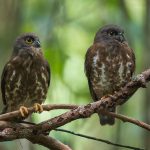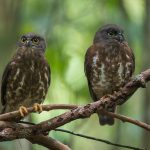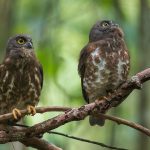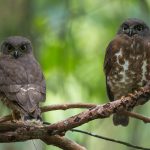The Brown Hawk-Owl (Ninox scutulata) or Brown Boobook is an owl which found in South Asia, South China to South-east Asia. It owes its name to its hawk-like appearance.
It is a commonly heard owl in Singapore, but less commonly seen. It has a distinct repeated and soft ‘ooup-ooup’ call at dusk and dawn that once you remember, will be rather easily heard in the Central Catchment Nature Reserve or Bukit Timah. On one of my recent trek through 1.6 km of Rifle Range Link, I heard at least six of them calling just before dawn.
Before 2014, most of my encounter with the owl species was either knowing where it roosted, or there was a deliberate attempt to call it out at a known location. However this year, I decided to actually learn local bird calls and rely more on my hearing senses to track birds. That would proved very useful later in the year. But that is another story for another time.
So on an evening in late February 2014, I decided to explore Venus Loop after work. As I recall, I was looking specifically for a Von Schrenck’s Bittern that I have seen a few days earlier but did not manage to photograph. But there was no bittern that evening, and I decided to walk out. It was past 7pm and it was getting dark.
Halfway through my exit, I heard a very soft call. I couldn’t exactly make out what it was, so I stood still and waited. Another call, and it confirmed my suspicion. There was a distant Brown Hawk-Owl calling. My response was to take out my phone and look through my bird calls library and play a known bird call back to confirm. I did that and then I raised the volume of the phone so that it rang louder. I was hoping to lure the bird out closer. But it would have none of that. It stopped and then started calling again at the same volume and position.
I decided to switch off the call and try to figure out its location instead. I thought it must be far away as the call was soft but I was curious to check it out nonetheless. I bashed through a bit out of the trail towards a stream. And I looked up to ascertain the direction of the sound again. To my utter surprise, the bird was less than 10 meters away. It looked directly at me and then continued its soft calls, looking left and right. I took the opportunity to shift to a position that was clear of obstructions and started evaluating the scene. It was dark alright as it was already 7:09pm. I knew I had to bump out ISO to a ridiculous value. ISO 6400, f/4 and 1/40s. I rattled a few shots and then some more. Too dark still, and I lowered the shutter speed to 1/25s. I knew that most of the shots will turn out soft at this shutter speed due to handshake but there was no other way.
Then out of nowhere, another owl flew in! It perched just next to the first one and it too was staring at me. By then the light was even darker. And I progressively lowered my shutter speed to 1/20s and upped the ISO to 12800. I took shots after shots as I knew I will throw away at least 95% of the shots.
Then the light became so low that the camera could no longer focus. I looked at the two owls that were still checking out their environment and decided, well that’s it. I will call it a day and leave them to start their work day instead. I walked out and by the time I reached my car, it was really dark. I had a good encounter and hoped that there were at least a few good shots to go with it.
So how did it turn out? I took approximately 1000 shots in the 10 minutes encounter, and most were discarded. There were 20 usable shots and 5 are shown in the gallery below. 2% keeper rate, and even those that were kept were very noisy and needed heavy software noise reduction. But technical difficulties aside, I am happy to have encountered the owls as a pair and made good on my goal of tracking birds through their calls.
What is there to learn? I have annotated each photos in the gallery and you can browse through for additional information. For photographers, the simple answer is bring a tripod to shoot owl and you get better pictures with less effort!
Photo Gallery
- The first owl. This was shot landscape and cropped vertical.
- The first owl is to the right and the second one is to the left. The second one is actually calling. See the raised throat area. As the owls were confiding, I could position myself so that both owls were in the same focal place, which is a stroke of good luck.
- The second oen is scanning the surrounding. You can differentiate the owl by eye colour. The one on the right have orange coloured eyes.
- Now both owls are calling with the right one puffed up as well. I do not know why they were calling even though they are already a pair.
- When they say that owls can turn their head 180 degrees, this is what they meant. Don’t be fooled by the brightness of the scene. After this photo, I could no longer focus the camera. The scene has been brightened to show the details of the owls.




